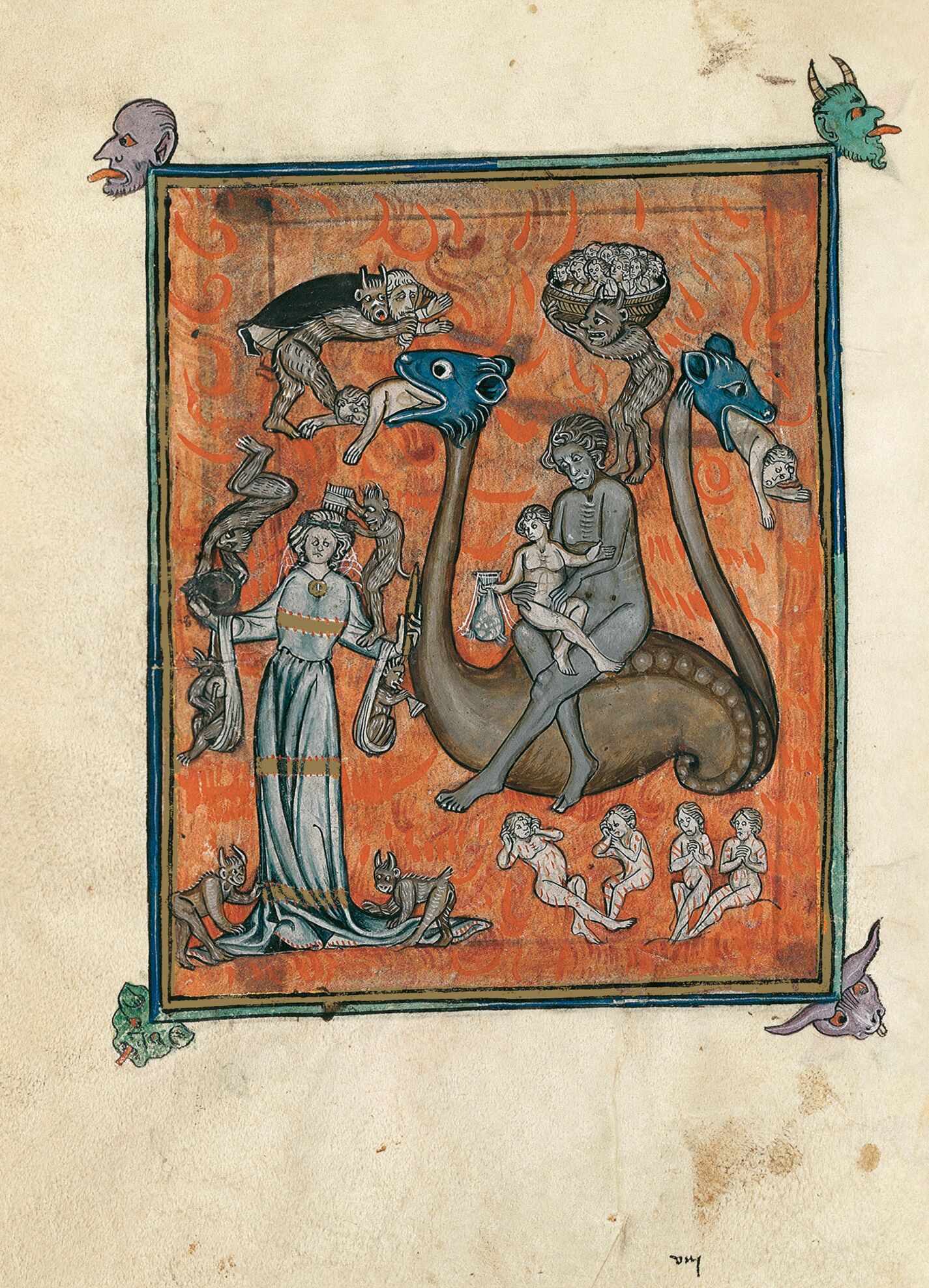After the reprobates move towards the mouth of Leviathan, Hell continues to be portrayed against a fiery, orangey background with red flames. The artist takes the reader into the depths of the hellish furnace where the personification of Hades, in the guise of a naked man with grey skin, is enthroned on the backbone of a wingless, brownish dragon with a protruding belly. Sitting on the knees of this figure is the chubby soul of a miser grasping a bag tied with cords, probably containing silver coins, the shape of which can be made out through the fabric. This antithetic figure of the bosom of Abraham depicted after the description of heavenly Jerusalem (f. 84) is framed by the beast’s neck and uplifted tail, both of which end with a blue head spitting out the souls condemned to be eaten, digested and spat out again by the monster for ever and ever. Two demons provide him with food: one carries a large basket filled with the damned heaped up like bread buns, whilst the other carts a select dish along on his shoulders, i.e. a religious who has probably not respected the rule and who, whilst no longer tonsured, still wears the habit of a Dominican or canon: a black cloak over a white robe. Four souls writhe in pain in the fire of punishment at the feet of Hades whilst a woman stands tall and elegant on the left of the composition. The demons bustle around her like chambermaids dressing a princess. Whilst two little devils adjust the folds in her long gown bedecked with orphreys, a third combs her hair crowned by a diadem, a fourth holds a mirror out to her and finally, another two more mischievous devils have tucked themselves inside her sleeves to play the trumpet and drum. This woman with a beautiful, pale face, holding a sort of gold awl by way of a sceptre, is shown as the opposite of the Lamb’s Wife adorned for the mystic nuptials (cf. f. 67). She is the image of the idolatry and lust embodied by Babylon, the dethroned queen cast into the kingdom of Satan following the example of the Beast and the Dragon (cf. f. 65).

After the reprobates move towards the mouth of Leviathan, Hell continues to be portrayed against a fiery, orangey background with red flames. The artist takes the reader into the depths of the hellish furnace where the personification of Hades, in the guise of a naked man with grey skin, is enthroned on the backbone of a wingless, brownish dragon with a protruding belly. Sitting on the knees of this figure is the chubby soul of a miser grasping a bag tied with cords, probably containing silver coins, the shape of which can be made out through the fabric. This antithetic figure of the bosom of Abraham depicted after the description of heavenly Jerusalem (f. 84) is framed by the beast’s neck and uplifted tail, both of which end with a blue head spitting out the souls condemned to be eaten, digested and spat out again by the monster for ever and ever. Two demons provide him with food: one carries a large basket filled with the damned heaped up like bread buns, whilst the other carts a select dish along on his shoulders, i.e. a religious who has probably not respected the rule and who, whilst no longer tonsured, still wears the habit of a Dominican or canon: a black cloak over a white robe. Four souls writhe in pain in the fire of punishment at the feet of Hades whilst a woman stands tall and elegant on the left of the composition. The demons bustle around her like chambermaids dressing a princess. Whilst two little devils adjust the folds in her long gown bedecked with orphreys, a third combs her hair crowned by a diadem, a fourth holds a mirror out to her and finally, another two more mischievous devils have tucked themselves inside her sleeves to play the trumpet and drum. This woman with a beautiful, pale face, holding a sort of gold awl by way of a sceptre, is shown as the opposite of the Lamb’s Wife adorned for the mystic nuptials (cf. f. 67). She is the image of the idolatry and lust embodied by Babylon, the dethroned queen cast into the kingdom of Satan following the example of the Beast and the Dragon (cf. f. 65).